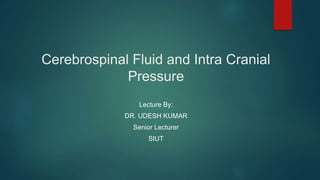
Central Nervous System.pptx
- 1. Cerebrospinal Fluid and Intra Cranial Pressure Lecture By: DR. UDESH KUMAR Senior Lecturer SIUT
- 2. What is Cerebrospinal Fluid? Cerebrospinal Fluid (CSF) is the clear colourless fluid that bathes the brain and spinal cord acting as fluid layer for protection of central nervous system.
- 3. Where CSF is produced? It is produced by four choroid plexuses, located in the third, fourth and lateral ventricles. It is produced at a rate o approximately 0.3ml per min. Total volume of CSF is approximately 150ml at any time, which equal to approximately 10% of intracranial volume. 450ml of CSF is produced per day and CSF volume is replaced 3times every 24hrs. CSF is derived from plasma filtration and subsequent secretion by choroid plexuses. CSF is one of three determinants of intracranial pressure (the other two being brain tissue & blood volume.
- 4. CIRCULATION OF CSF OR (CSF FLOW TRACT) CSF flows from choroid plexuses of lateral ventricles through foramina of Monroe into third ventricle & from there via aqueduct of sylvius into fourth ventricle. Then CSF leaves ventricular system via midline foramen of Magendie & lateral Foramen of lushka then entering the subarachnoid space of brain & spinal cord. CSF is absorbed into dural venous sinuses via arachnoid villi & granulations that project into dural sinuses.
- 5. WHAT IS BLOOD-BRAIN BARRIER(BBB)? Plasma constituents do not pass freely into CSF this phenomenon is known as blood-brain barrier. Anatomical & physiological factors involved in maintaining the BBB are: Tight junctions & fenestrated choroidal capillaries within brain. Specialized bidirectional transport system for ions, glucose % amino acids.
- 6. Causes of Blood Brain Barrier (BBB) Disruption Severe hypertension Tumors Trauma Strokes Infections Hypercarbia Hypoxia Sustained seizure activity
- 7. NORMAL CSF COMPOSITION Protein 0.15-0.50 g/L Osmolality 280-300 m mol/L Sodium 135-145 mmol/L Potassium 2.6-3.0 mmol/L Chloride 115-125 mmol/L Calcium 1-1.40 mmol/L Magnesium 1.2-1.5 mmol/L Lactate 1.1-2.4 mmol/L PH 7.28-7.40mmol/L
- 8. Creatinine 50-110 umol/L Glucose 2.8-4.4 mmol/L Urea 3-6.5 mmol/L Note: Comparison of the composition of CSF and Plasma reveals that: CSF Proteins are 1% that of Plasma CSF Calcium levels are 50% that of Plasma CSF Glucose levels are 60% that of Plasma CSF Chloride & Magnesium levels are higher than Plasma
- 9. Investigations performed on CSF sample Opening Pressure: Traditionally measured in cm H2O (Normally= 10-15 lying down, 20-30 cm H2O Sitting up) and this is elevated in raised ICP. Total and differential cell count Bacterial culture and sensitivity Protein and Glucose Analysis of immunoglobulins (Detect chronic CNS inflammatory condition) Cytology
- 10. Intracranial Pressure (ICP) Intracranial Pressure means supratentorial CSF pressure measured in lateral ventricles. Normally < 10mmhg
- 11. Intracranial Pressure (ICP) Intracranial components Brain 80% Blood 12% CSF 8% Adult Brain : Blood Flow CBF = 750 ml / min (20% of cardiac output)
- 12. Etiology of raised ICP Haemorrhage in Brain Tumor Trauma Stroke Aneurysm High BP Brain infection
- 13. Monroe – Kelly Doctrine Theory Cranial vault is rigid structure with fixed volume. Brain 80% Blood 12% CSF 8% Any increase in one component must be offset by an equivalent decrease in another to prevent rise in ICP.
- 14. Measurement methods of ICP 1. Intra Ventricular Catheter OR Extra Ventricular Drain (Gold Standard) 2. Extra dural Probe 3. Transcranial doppler 4. Sub arachnoid probe 5. Intra parenchymal probe 6. Lumber CSF Pressure 7. Tympanic membrane displacement
- 15. Treatment of raised ICP 1. Improving venous drainage from brain: a. Elevated head of bed 30 degree b. Neutral position c. Tap the ETT rather than tie 2. Reduced cerebral edema: a. Using Mannitol 10% 5-10 ml/kg OR 20% 2.5 – 5 ml/kg b. Furosemide 0.5-1 mg/kg
- 16. Treatment of raised ICP 3. Reduced CMRO2: a. Close temperature monitoring (so avoid Hyperthermia & Hypothermia) b. For seizures (Use phenytoin 18 mg/kg 4. Reduced Intracranial Blood Volume: a. Hyperventilation (To decrease PaCO2 28-30 mmhg
- 17. Treatment of raised ICP 5. Reduce CSF Volume: a. Extra Ventricular Drain (EVD) allows drainage of CSF to relieve increased ICP. 6. Final resort for treatment of raised ICP: a. Perform decompressive craniotomy.
- 18. Thank you